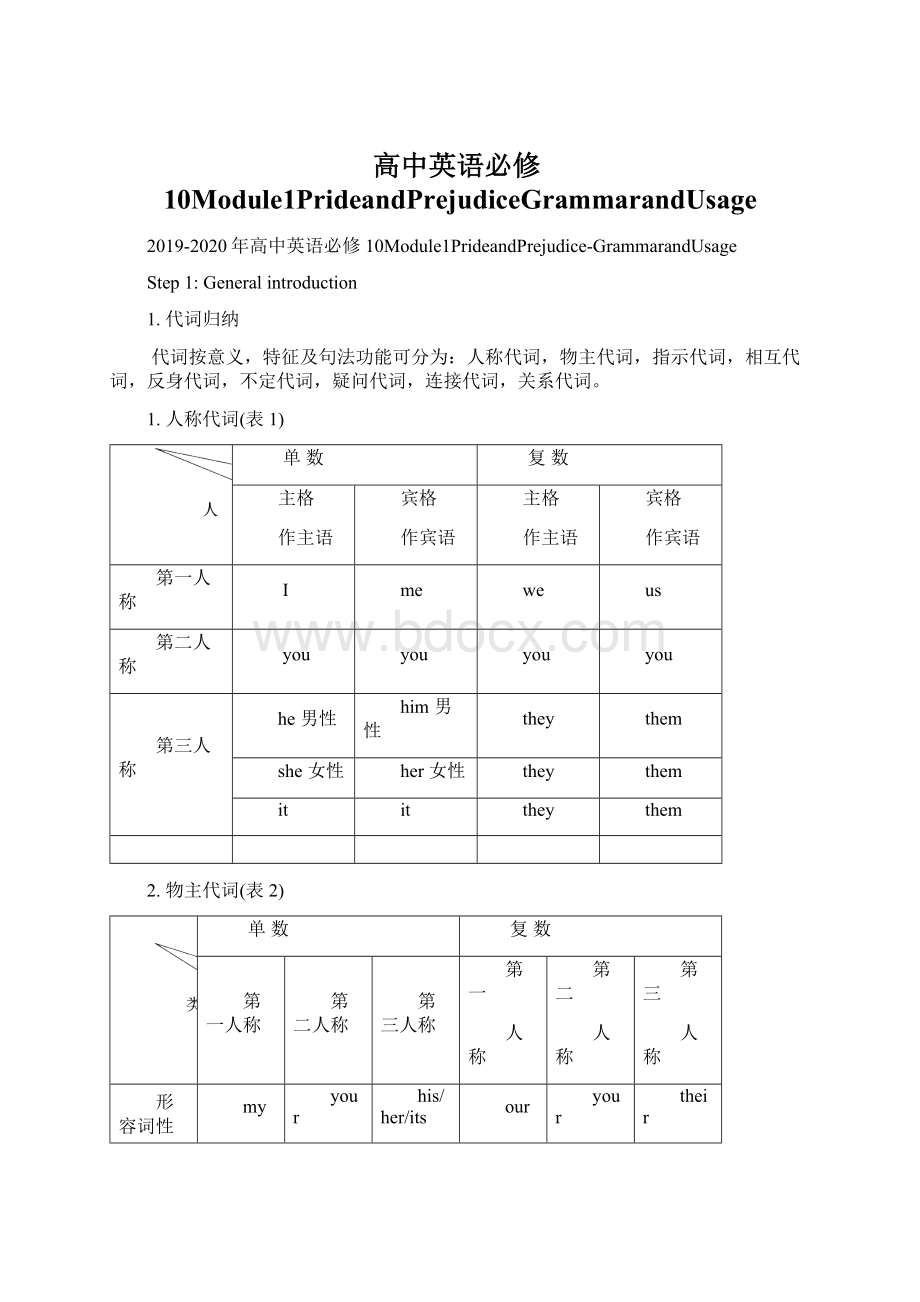高中英语必修10Module1PrideandPrejudiceGrammarandUsage.docx
《高中英语必修10Module1PrideandPrejudiceGrammarandUsage.docx》由会员分享,可在线阅读,更多相关《高中英语必修10Module1PrideandPrejudiceGrammarandUsage.docx(22页珍藏版)》请在冰豆网上搜索。

高中英语必修10Module1PrideandPrejudiceGrammarandUsage
2019-2020年高中英语必修10Module1PrideandPrejudice-GrammarandUsage
Step1:
Generalintroduction
1.代词归纳
代词按意义,特征及句法功能可分为:
人称代词,物主代词,指示代词,相互代词,反身代词,不定代词,疑问代词,连接代词,关系代词。
1.人称代词(表1)
单数
复数
主格
作主语
宾格
作宾语
主格
作主语
宾格
作宾语
第一人称
I
me
we
us
第二人称
you
you
you
you
第三人称
he男性
him男性
they
them
she女性
her女性
they
them
it
it
they
them
2.物主代词(表2)
单数
复数
第一人称
第二人称
第三人称
第一
人称
第二
人称
第三
人称
形容词性物主代词
my
your
his/her/its
our
your
their
名词性物主代词
mine
yours
his/hers/its
ours
yours
theirs
3.指示代词
this,that,these,those
1表示近指,用this,these;表示远指,用that,those.
2指代上文的事物时,用this或that;引出下文的事物时,常用this;指代前面所述两个事物中的前者用that,后者用this.
例如:
Healthisabovewealth,forthiscannotgivesomuchhappinessasthat.
③为避免重复,前面提到过的名词,多用that,those代替,该名词是可数单数或不可数名词时用that;是复数名词用those,既可以代人,也可以代物,但those后一定要有修饰语。
4.相互代词和反身代词
相互代词有eachother和oneanother
反身代词有:
(和人称代词对应表)(表3)
单数
复数
第一人称
第二人称
第三人称
第一
人称
第二
人称
第三
人称
人称代词
I
you
he/she/it
we
you
they
反身代词
myself
yourself
himself/
herself/itself
ourselves
yourselves
themselves
反身代词的常见搭配:
byoneselfforoneselfbenotoneselfetooneselftalktooneselfmakeoneselfathomeseatoneselfenjoyoneselfdressoneselfdevoteoneselftohelponeselftokilloneselfintroduceoneselfbehaveoneself
5.不定代词
①容易混淆的不定代词辨析
both,all,neither,none,either,any(表4)
二者
三者或三者以上
肯定
both(都)/either(任意一)
all(都)/any(任意一)
否定
neither
none
疑问
either
any
e.g.Therearemanytreesoneithersideofthestreet.
Therearemanytreesonbothsidesofthestreet.
Thestudentsarestandingonallsidesoftheplayground.
nothing,nobody,none,noone(表5)
类属
只能指人
nobody,noone
只能指物
nothing
既可指人,又可指物
none
场合
回答What…?
问句
nothing
回答Who…?
问句
nobody/noone
回答Howmany/much或Is/Arethere…?
问句
none
结构
可跟of短语
none,nothing
不可跟of短语
nobody,noone
e.g.---Whatwereyoudoingyesterdayafternoon?
---Nothing.
---Whoareyoutalkingwith?
---Nobody/Noone.
---Howmanyelephantscanyouseeinthezoo?
---None.
---Arethereanystudentsintheclassroom?
---None.
---Haveyouanymoneywithyou?
Ineedsomebadly.
---Sorry,butnoneatall.
some及some类词与any及any类词(表6)
一般用法
特殊用法
肯定句
some及some类词
any及any类词(表示任何人或事)
否定句
any及any类词
疑问句
any及any类词
some及some类词(表示向对方征求意见,提出请求或预料期望会得到答复和行动)
条件句
any及any类词
e.g.Iaskedhimforsomepaper,buthehadn’tany.
Ihavenomoneyonme.Wouldyoupleaselendmesome?
I’mverythirsty.Canyougivemesomethingtodrink?
Ifyouneedsomehelp,letmeknow.
---Whatwouldyouliketodrink?
---Itdoesn’tmatter.Anythingwilldo.
many,much,(a)few,(a)little(表7)
表示肯定意义
表示否定意义
修饰或代替可数名词
afew,many
few
修饰或代替不可数名词
alittle,much
little
e.g.Hehasworkedatthatfactoryfortenyears,buthehasfewgoodfriendsthere.
Hehasworkedatthatfactoryfortenyears,buthehasonlyafewgoodfriendsthere.
---Arethenewrulesworking?
---Yes.Fewbooksarestolen.
other,another,more,else(表8)
意义
搭配
other
其他的
some/any/many/several/no/数词+other+复数名词
noother+单数名词
everyother+单数名词
another
另外的,再
another+数词+复数名词
more
另外的,再
afewmore+可数复数
alittlemore+不可数
somemore+可数复数或不可数
用于肯定句中
稍多点…
anymore+可数复数或不可数
用于疑问,否定或条件句
nomore+可数复数或不可数
something/anything/nothing+more
manymore+可数复数
muchmore+不可数
多得多…
else
其他的,别的
Wh-+else…?
/复合不定代词+else/-where+else
e.g.Wouldyoupleasestayhereforafewmoreminutes?
Ihavesomequestionstoaskyou.
---Wouldyoulikesomemorerice?
---No,thank.Ihavehadenough.
Therearemuchmorewaterinthisbottlethaninthatone.
Justamoment,please!
I’llfinishinanotherfiveminutes.
---Whatelsewouldyouliketohave?
---No,nothingelse.
---Doyouhaveanythingmoretosay?
---No,nothingmore.
(the)other,(the)others,another(表9)
表示没有范围的“其他”
other+单数名词
other+(数词)+复数名词
others单独使用
表示一定范围之内的“其他”
theother+数词
theother+数词+复数名词
theothers单独使用
三者或三者以上不定数目中的“另一个”
another+单数名词或one
another单独使用
两者中的“另一个”
theother+单数名词
theother单独使用
e.g.Ofmythreeforeignfriends,oneisfromLondon,theothertwoarefromNewYork.
SomepeopleliketostayathomeonSunday,butothersliketogotothecinema.
Ihavetwobrothers.Oneisateacher;theotherisadoctor.
Ihavesixcolorpencils.Oneisred,anotherisblueandtheothersareallgreen.
Therearefiftystudentsinourclass.SomearefromtheUSAandtheothersarefromChina.
部分否定与全部否定问题
not和all,each,every,both,everything,everybody等连用时,不论not放在其前还是其后,均表示部分否定。
“并非都……”
其相应得全部否定表示为none,no,not…any,not…either,neither,noone,nobody.“都不……”。
e.g.Bothofthebooksarenotinteresting.=Notbothofthebooksareinteresting.=Oneofthetwobooksisinteresting,and